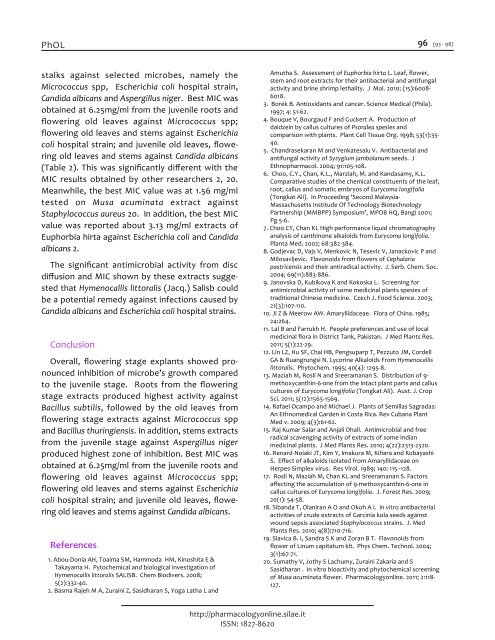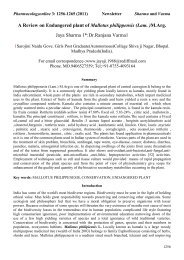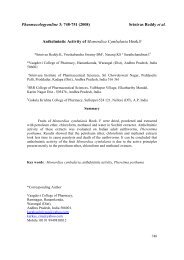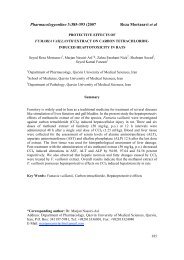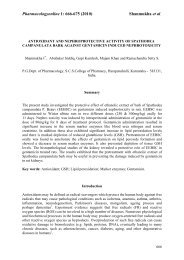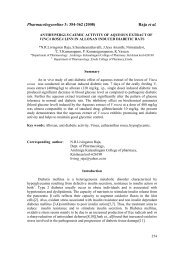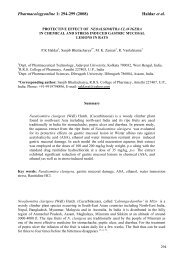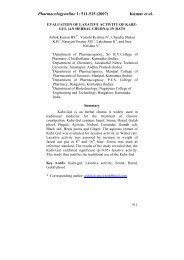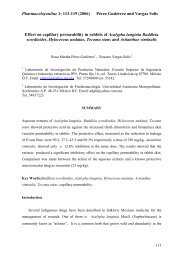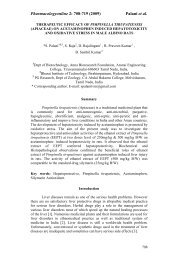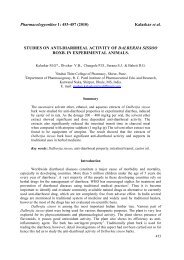Screening of potential antimicrobial activity from Hymenocallis littoralis
Screening of potential antimicrobial activity from Hymenocallis littoralis
Screening of potential antimicrobial activity from Hymenocallis littoralis
You also want an ePaper? Increase the reach of your titles
YUMPU automatically turns print PDFs into web optimized ePapers that Google loves.
PhOL<br />
stalks against selected microbes, namely the<br />
Micrococcus spp, Escherichia coli hospital strain,<br />
Candida albicans and Aspergillus niger. Best MIC was<br />
obtained at 6.25mg/ml <strong>from</strong> the juvenile roots and<br />
flowering old leaves against Micrococcus spp;<br />
flowering old leaves and stems against Escherichia<br />
coli hospital strain; and juvenile old leaves, flowering<br />
old leaves and stems against Candida albicans<br />
(Table 2). This was significantly different with the<br />
MIC results obtained by other researchers 2, 20.<br />
Meanwhile, the best MIC value was at 1.56 mg/ml<br />
tested on Musa acuminata extract against<br />
Staphylococcus aureus 20. In addition, the best MIC<br />
value was reported about 3.13 mg/ml extracts <strong>of</strong><br />
Euphorbia hirta against Escherichia coli and Candida<br />
albicans 2.<br />
The significant <strong>antimicrobial</strong> <strong>activity</strong> <strong>from</strong> disc<br />
diffusion and MIC shown by these extracts suggested<br />
that <strong>Hymenocallis</strong> <strong>littoralis</strong> (Jacq.) Salisb could<br />
be a <strong>potential</strong> remedy against infections caused by<br />
Candida albicans and Escherichia coli hospital strains.<br />
Conclusion<br />
Overall, flowering stage explants showed pronounced<br />
inhibition <strong>of</strong> microbe’s growth compared<br />
to the juvenile stage. Roots <strong>from</strong> the flowering<br />
stage extracts produced highest <strong>activity</strong> against<br />
Bacillus subtilis, followed by the old leaves <strong>from</strong><br />
flowering stage extracts against Micrococcus spp<br />
and Bacillus thuringiensis. In addition, stems extracts<br />
<strong>from</strong> the juvenile stage against Aspergillus niger<br />
produced highest zone <strong>of</strong> inhibition. Best MIC was<br />
obtained at 6.25mg/ml <strong>from</strong> the juvenile roots and<br />
flowering old leaves against Micrococcus spp;<br />
flowering old leaves and stems against Escherichia<br />
coli hospital strain; and juvenile old leaves, flowering<br />
old leaves and stems against Candida albicans.<br />
References<br />
1. Abou-Donia AH, Toaima SM, Hammoda HM, Kinoshita E &<br />
Takayama H. Pytochemical and biological investigation <strong>of</strong><br />
<strong>Hymenocallis</strong> <strong>littoralis</strong> SALISB. Chem Biodivers. 2008;<br />
5(2):332-40.<br />
2. Basma Rajeh M A, Zuraini Z, Sasidharan S, Yoga Latha L and<br />
http://pharmacologyonline.silae.it<br />
ISSN: 1827-8620<br />
96 (93 - 98)<br />
Amutha S. Assessment <strong>of</strong> Euphorbia hirta L. Leaf, flower,<br />
stem and root extracts for their antibacterial and antifungal<br />
<strong>activity</strong> and brine shrimp lethality. J Mol. 2010; (15):6008-<br />
6018.<br />
3. Borek B. Antioxidants and cancer. Science Medical (Phila).<br />
1997; 4: 51-62.<br />
4. Bouque V, Bourgaud F and Guckert A. Production <strong>of</strong><br />
daidzein by callus cultures <strong>of</strong> Psoralea spesies and<br />
comparison with plants. Plant Cell Tissue Org. 1998; 53(1):35-<br />
40.<br />
5. Chandrasekaran M and Venkatesalu V. Antibacterial and<br />
antifungal <strong>activity</strong> <strong>of</strong> Syzygium jambolanum seeds. J<br />
Ethnopharmacol. 2004; 91:105-108.<br />
6. Choo, C.Y., Chan, K.L., Marziah, M. and Kandasamy, K.L.<br />
Comparative studies <strong>of</strong> the chemical constituents <strong>of</strong> the leaf,<br />
root, callus and somatic embryos <strong>of</strong> Eurycoma longifolia<br />
(Tongkat Ali). In Proceeding ‘Second Malaysia-<br />
Massachusetts Institude Of Technology Biotechnology<br />
Partnership (MMBPP) Symposium’, MPOB HQ, Bangi 2001;<br />
Pg 5-6.<br />
7. Choo CY, Chan KL High performance liquid chromatography<br />
analysis <strong>of</strong> canthinone alkaloids <strong>from</strong> Eurycoma longifolia.<br />
Planta Med. 2002; 68:382-384.<br />
8. Godjevac D, Vajs V, Menkovic N, Tesevic V, Janackovic P and<br />
Milosavljevic. Flavonoids <strong>from</strong> flowers <strong>of</strong> Cephalaria<br />
pastricensis and their antiradical <strong>activity</strong>. J. Serb. Chem. Soc.<br />
2004; 69(11):883-886.<br />
9. Janovska D, Kubikova K and Kokoska L. <strong>Screening</strong> for<br />
<strong>antimicrobial</strong> <strong>activity</strong> <strong>of</strong> some medicinal plants spesies <strong>of</strong><br />
traditional Chinese medicine. Czech J. Food Science. 2003;<br />
21(3):107-110.<br />
10. Ji Z & Meerow AW. Amaryllidaceae. Flora <strong>of</strong> China. 1985;<br />
24:264.<br />
11. Lal B and Farrukh H. People preferences and use <strong>of</strong> local<br />
medicinal flora in District Tank, Pakistan. J Med Plants Res.<br />
2011; 5(1):22-29.<br />
12. Lin LZ, Hu SF, Chai HB, Pengsuparp T, Pezzuto JM, Cordell<br />
GA & Ruangrungsi N. Lycorine Alkaloids From <strong>Hymenocallis</strong><br />
<strong>littoralis</strong>. Phytochem. 1995; 40(4): 1295-8.<br />
13. Maziah M, Rosli N and Sreeramanan S. Distribution <strong>of</strong> 9methoxycanthin-6-0ne<br />
<strong>from</strong> the intact plant parts and callus<br />
cultures <strong>of</strong> Eurycoma longifolia (Tongkat Ali). Aust. J. Crop<br />
Sci. 2011; 5(12):1565-1569.<br />
14. Rafael Ocampo and Michael J. Plants <strong>of</strong> Semillas Sagradas:<br />
An Ethnomedical Garden in Costa Rica. Rev Cubana Plant<br />
Med v. 2009; 4(3):61-62.<br />
15. Raj Kumar Salar and Anjali Dhall. Antimicrobial and free<br />
radical scavenging <strong>activity</strong> <strong>of</strong> extracts <strong>of</strong> some Indian<br />
medicinal plants. J Med Plants Res. 2010; 4(22):2313-2320.<br />
16. Renard-Noiaki JT, Kim Y, Imakura M, Kihara and Kobayashi<br />
S. Effect <strong>of</strong> alkaloids isolated <strong>from</strong> Amaryllidaceae on<br />
Herpes-Simplex virus. Res Virol. 1989; 140: 115–128.<br />
17. Rosli N, Maziah M, Chan KL and Sreeramanan S. Factors<br />
affecting the accumulation <strong>of</strong> 9-methoxycanthin-6-one in<br />
callus cultures <strong>of</strong> Eurycoma longifolia. J. Forest Res. 2009;<br />
20(1): 54-58.<br />
18. Sibanda T, Olaniran A O and Okoh A I. In vitro antibacterial<br />
activities <strong>of</strong> crude extracts <strong>of</strong> Garcinia kola seeds against<br />
wound sepsis associated Staphylococcus strains. J. Med<br />
Plants Res. 2010; 4(8):710-716.<br />
19. Slavica B. I, Sandra S K and Zoran B T. Flavonoids <strong>from</strong><br />
flower <strong>of</strong> Linum capitatum kit. Phys Chem. Technol. 2004;<br />
3(1):67-71.<br />
20. Sumathy V, Jothy S Lachumy, Zuraini Zakaria and S<br />
Sasidharan . In vitro bio<strong>activity</strong> and phytochemical screening<br />
<strong>of</strong> Musa acuminata flower. Pharmacologyonline. 2011; 2:118-<br />
127.


